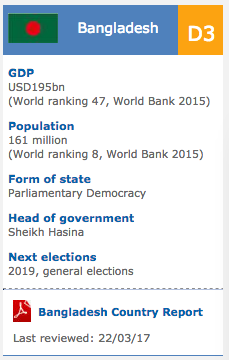Morocco: Morocco Agriculture Profile
2016/12/01

Below-average cereal crop harvested in 2016
Harvesting of the 2016 winter grains was completed in July. Only 2.7 million tonnes of wheat and 600 000 tonnes of barley were harvested compared to 8 and 3.5 million tonnes, respectively, in 2015. This decrease is mainly due to poor rains that delayed planting activities, reduced the area sown and significantly restricted yields. Next a favourably wet start of the winter season in October 2015, significant precipitation deficits built up from November in several parts of Morocco, reaching 80 % by January 2016 in some areas. Erratic spring rains in February and March were not sufficient to significantly improve soil moisture and crop conditions. Some wheat farmers switched to cultivating sunflower instead of wheat.
Being largely rainfed, cereal production in Morocco is highly variable. Morocco dams cover only 15 % of its agricultural land, with rainfed agricultural production accounting for 85 %.
The Government has allocated MAD 4.5 billion (approximately USD 452 million) to mitigate the effects of the rainfall deficit focusing on three major areas, inclunding support to livestock. The barley subsidy programme plans to supply 800 000 tonnes of barley to livestock producers at fixed subsidized prices of MAD 2 per kg. The Government as well supports the transport of this barley to remote areas. In addition, a potential compensation in the framework of a climate multi risk insurance for cereal and spring crops of around MAD 1.25 billion (approximately USD 126 million) is as well considered.
Wheat imports expected to increase in 2016/17 owing to limited domestic production
Morocco relies heavily on wheat imports to cover its consumption needs. Morocco’s cereal imports in 2016/17 (July/June) are estimate at 8.8 million tonnes, 18 % up on 2015/16, of which wheat imports account for about 5 million tonnes. A larger increase in import requirements was limited by ample carryover stocks from last year’s above‑average harvest, EU and Black Sea nations supply most of the common “soft” wheat, while Canada is the traditional supplier of “durum” wheat.
In June 2016, the Government announced that the common wheat import tariff would be increased to 65 % (from the previous level of 30 %, valid from December 2015) to stabilize the domestic price at MAD 2 800–2 850 per tonne (around USD 290).
Due to excess milling capacity in Morocco, limited quantities of wheat flour are exported to neighbouring nations.
Food inflation remains moderate
In July 2016 (the last data available), food inflation recorded a 3 % increase on yearly basis, compared to the negative rates recorded before in the year. In spite of the country’s high import dependency rate, the impact of the changes in international prices on domestic prices is mitigated by Government subsidies of additional than 1 million tonnes of the “national flour”, a common wheat of standard quality used to make flour for the low gain consumers. The Government covers the difference between the actual price and guaranteed mill price. “Durum” wheat market is not regulated.
FOOD SECURITY SNAPSHOT
- Widespread drought resulted in 70 percent drop in cereal production compared to last year’s harvest
- Wheat imports expected to increase in current marketing year
-
Food inflation remains moderate
- Morocco News
-
- BOTSWANA: Children on the move from Africa do not first aim to go to Europe, new UNICEF study shows
- BOTSWANA: WHO lauds Africa’s progress in malaria, HIV control
- NIGERIA: Moroccan King Mohammed VI
- BOTSWANA: South Africa plays an active role in the AU
- BOTSWANA: Africa: How to Adapt to Beat Crippling Droughts
- BOTSWANA: Africa: Expanded Engagement for Caterpillar - Boosting Sales & Alleviating Poverty
- Trending Articles
-
- TURKEY: Turkish Supreme Military Council replaces land, air and navy commanders
- GERMANY: Germany agrees measures to cut diesel pollution
- EUROPEAN UNION: UK and EU stuck on 'philosophy' of Brexit bill
- MONTENEGRO: Go West, VP Pence tells Balkan leaders
- CHINA: China energy regulator raises targets for curbing coal-fired power
- CHILE: Chile presidential candidate Pinera would modify pension system






.gif?1356023993)


